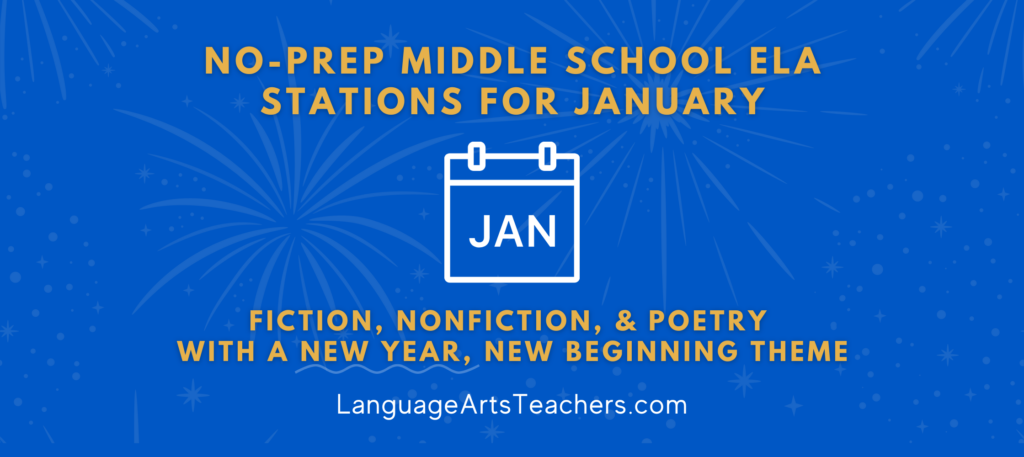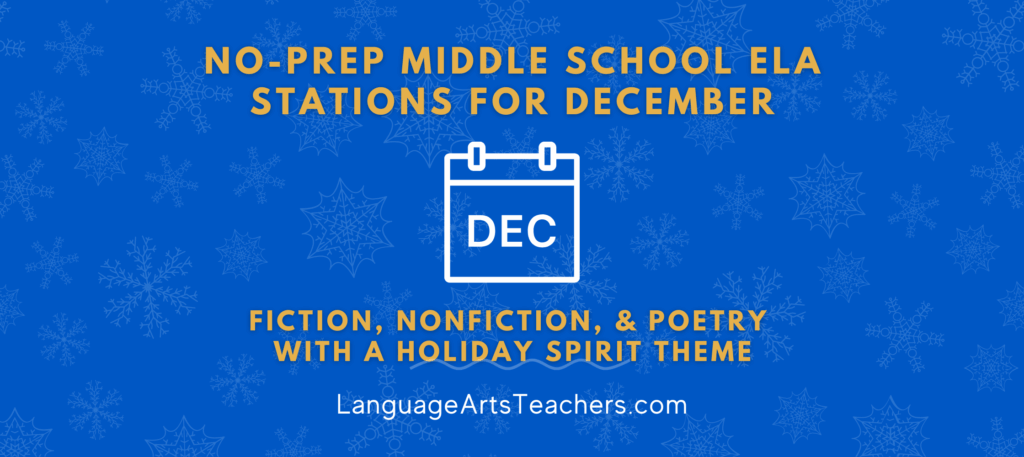AI writing tools are new, controversial, and a source of anxiety for teachers and parents who know how important it is for middle school students in English Language Arts classrooms to develop the skill of writing and communication. (Me + AI)
Years and years ago, I remember hearing teachers panic about the capabilities of Google when it flipped the drawers of the card catalog system on their heads. Teachers thought students would grow up never having to conduct research ever again! >> In reality, the issue is that we now have soooo much information at our fingertips that we have to use a whole new set of skills to combat information overload, analysis paralysis, and data overwhelm. (All that’s me, not AI)
Google didn’t go away, and it didn’t obliterate the skills of careful research, either. The same concept may apply to the new AI writing tools as well because AI writing tools aren’t going away, either. (Hi, still me)
I know from personal experience in writing this exact article (well, um. . . kind of?) that AI doesn’t totally do all the work for you, though. <– More on that in a minute.
AI uses artificial intelligence and natural language processing to analyze sentences, provide feedback, and suggest changes. AI writing tools can be used in a variety of ways, from checking grammar and spelling to helping students through their writing process. (All AI)
What we’ll do here in this blog post is explore several ways students *could* leverage AI writing tools (guided by teachers who are learning all this, too) to become better writers in middle school ELA classes. From grammar and spell-checking to organization and paragraph structure, maybe AI writing tools can be used to help students improve their writing skills and become more confident in their ability to express ideas through writing. (AI)

What Are AI Writing Tools?
AI writing tools are online tools that use AI (artificial intelligence) to generate writing of all types. (AI)
Where does the actual content come from? (<–That’s my thought, not AI’s).
Um . . . I don’t know yet! (<– That’s my input, not AI’s).
I’m new to this, too, and I’m just trying to figure out if there’s a way to work WITH it rather than AGAINST it (the whole we fear what we don’t understand thing).
From what I’m diving into right now, I’m thinking that perhaps AI writing tools could help provide students with feedback and suggestions based on the content of their writing. AI might also help students with organization and paragraph structure, vocabulary development, and even grammar and spelling.
Some names or types of AI writing tools are Hemingway, Ginger, and SmartWriting. This exact article, as an example of AI, is using a tool I’m playing with called WriteSonic.
***Hold up. Let me stop and share some thoughts right now before moving back to our topic of AI in middle school ELA classes.
^^^ All those paragraphs above were actually generated like this:
(1) I had to tell the WriteSonic AI tool a specific topic I had in mind
(2) I had to select the best “narrowed down” topic from the general ones AI suggested
(3) I had to tweak the title of this blog post so it made sense for the topic (I had to think ahead)
(4) I had to break up every single paragraph above because they originally came out all in one big paragraph (I had to rely on my own understanding of paragraph structure, content organization, etc).
(5) I wanted to emphasize certain words (all caps, italics, etc.) to get my point across in my voice) while also adding in my thoughts and ideas that AI couldn’t possibly know (because they’re like, my own thoughts…)
(6) I had to shift the verb tense multiple times for several words and phrases to make everything ‘correct’ AND I had to omit certain phrases that seemed too repetitive.
–> In other words, I still had to think, revise, re-read, edit, make changes, organize and reorganize . . . But I didn’t have to start from scratch with the blinking cursor of writing death.
*** The list of 6 steps above plus the paragraph below it starting with “In other words” were my own unique, added additions that AI didn’t (couldn’t?) generate for me.
After all, AI is not my brain. It’s not my personality and it’ll never share my life experiences, memories, or ideas (Right? Hopefully not.)
Benefits of Using AI Writing Tools in Middle School ELA Classes
One of the main benefits of using AI writing tools is that they could allow students to become more independent in their writing process. Instead of having to wait for a teacher to proofread and edit their work, students could use AI writing tools to check their grammar and spelling, as well as receive feedback on their writing. (<– I changed very little in this paragraph. It pretty much appears here the same way it was generated)
AI writing tools could also be used to help students develop and practice their skills in organizing their ideas, and correcting grammar and spelling.
Sentence and Paragraph Structure
Tools like Ginger and Hemingway are designed specifically to help students organize their ideas into cohesive, logical paragraph structures. (Yes, pleeease!)
Students can input their written work and select specific areas to focus on, like sentence structure, transitions, or vocabulary usage. The AI will analyze the piece and provide feedback on strengths and weaknesses. Students can then use that feedback to make adjustments and re-input their work for another set of suggestions. (<– I changed very little in this paragraph)
While this is all happening, students would still have to think, analyze, consider what modifications to accept or deny, and then evaluate the impact in their overall writing assignment. (<– I had to break up this entire section and make several modifications).
Rewriting and Paraphrasing Tools
These tools provide a quick way for students to mark up their work with their own comments, suggestions, and changes. Students can look at their original writing to see what they want to change, edit, or add and then select the areas they want to comment on. Students can then choose whether they want to make changes in the original document or in a new document. The AI analyzes that content and provides a new piece of writing. This (might?) help students avoid plagiarism while also allowing them to improve their writing skills. (<– I changed very little in this paragraph. It pretty much appears here the same way it was generated)
Grammar and Spell Checking Tools
Ginger and other AI writing tools can provide quick feedback on obvious grammar and spelling mistakes. Unlike traditional spell checkers, however, these tools can provide feedback on appropriate usage and suggest edits that help improve a piece of writing. Ginger can analyze a piece of writing, mark the areas that might be problematic, and then provide alternatives to help improve students’ written work. This could be helpful for students who might not always be able to identify and correct their own mistakes. (<– Again, I changed very little in this paragraph).
Revising and Editing
Many AI writing tools provide feedback beyond just spelling and grammar mistakes. They can also analyze a piece and provide suggestions on how the piece can be improved. This can be helpful for students who might not know how to improve their work and make it more effective. AI writing tools can provide suggestions for additions, deletions, and changes that can make a written piece better. (<– I changed nothing in this paragraph, but I have to wonder HOW a student would know what additions, deletions, and changes would make their writing better. You know what I mean? They don’t know what they don’t know, so how would they actually know which changes to accept from AI’s suggestions and which ones to deny?)
Conclusion
Ultimately, AI writing tools could provide students with feedback and suggestions that would (hopefully) help improve the quality of their written work. Using these tools would potentially allow students to become more independent in their writing while also improving their writing skills. If students can take advantage of these tools, they might greatly improve their written work and become more confident in their writing abilities. (AI)
Hi! I’m back. This is me, Laura Kebart now, NOT AI. Here’s my final takeaway from this little I’m going to use AI to write my next blog post experiment:
// AI can’t replace human feelings or all the things we experience that play into our writing
// AI can help us brainstorm, organize ideas, and give us a starting point for our writing
// We can learn more about a topic by asking AI to generate content for us about it (Ex: I didn’t know about Ginger or Hemingway as AI tools… I knew of others, but not those two).
// We still have to know the rules of writing before we can allow AI to apply or deny them on our behalf (We can’t blame AI if we ‘allow’ it to get something wrong for us).
// AI could ‘trick’ us into applying or denying revisions, edits, etc. if we don’t have a solid foundation of what good writing is
// AI will generate a “long enough” or “short enough” piece of writing that to a naive student, will seem like a win-win guaranteed A while in reality, it likely won’t make much sense. It’s one of those too-good-to-be-true technologies that doesn’t completely eliminate the need for thinking, planning, revising, editing, and proofreading. Students still need to learn, develop, practice, and implement those skills so that WHEN they turn to AI for content development, they know good content when they see it and they know how to take mediocre content and amplify it.
All ^that being said, I’m sure I’ve barely learned all that there is to learn about the new AI tools. My hope is that this blog post gave you a new perspective as it did for me. I’m not like “all in” on AI, but I’m not afraid of it, either. It’s a tool available to us that we can use or abuse just like any other advancement in technology. The more we understand it though, the more we’ll be able to help our students navigate it, too, so that they can learn to use it for good.
⭐️If you are currently looking for an online English teacher position, give Jooble a try!⭐️



